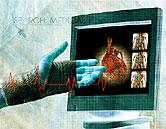
WEDNESDAY, Jan. 19 (HealthDay News) — Twenty percent of heart attack patients stand a good chance of suffering a second attack over the following three years, an event that is nearly as likely to be caused by a new blockage as by the original one, a new study suggests.
Researchers from Columbia University Medical Center/New York-Presbyterian Hospital also found that most new blockages responsible for second heart attacks had appeared mild during the initial cardiac workup.
A group of 697 patients with acute coronary syndrome — an umbrella term describing chest pain due to poor blood supply to the heart — underwent angiogram and ultrasound imaging tests to track artery blockages called lesions. The group, three-quarters of whom were men, was followed for a median of 3.4 years.
“The first thing is, those who come in with a heart attack or a threatened heart attack and get a successful angiogram . . . have very low chances of a heart attack over the next three years,” said study author Dr. Gregg W. Stone, director of cardiovascular research and education at New York-Presbyterian/Columbia. “That’s the good news.”
“I think the whole thing was certainly illustrative,” Stone added. “It gave us a lot of insights into the history of atherosclerosis we didn’t have.”
Lesions that caused subsequent cardiac events — including death, heart attack or progressive angina pain — were identified as previously treated or untreated. About 20 percent of patients suffered later cardiac events over a three-year period, according to the study.
So-called “culprit” lesions, which caused the first heart attack, were found to be responsible for 12.9 percent of later events, while “non-culprit” lesions that had previously appeared mild on angiograms caused 11.6 percent of later events.
“If you do have those hidden blockages . . . they’re going to obviously intensify,” Stone said. “Now the question is, is there anything we can do to prevent them from becoming symptomatic in the future?”
The study is reported in the Jan. 20 issue of the New England Journal of Medicine.
Dr. Gregg C. Fonarow, a professor of cardiology at the University of California, Los Angeles, said he thought the research was well-done and that it confirms prior studies that identified lesions that went on to cause successive cardiac events.
The message of the study, Fonarow said, is that heart disease needs to be treated systemically with diet, exercise and medication, in addition to treating detectable blockages.
“Just because you have a normal stress test doesn’t mean you’re out of the woods. Fundamental treatment needs to focus on treating the underlying disease,” Fonarow said.
“There’s no question treating the culprit lesion is critical,” he added. “Even in these patients with known disease, there are further opportunities to improve their condition. There are many other lesions that don’t show up on the angiogram . . . that are definitely amenable to the cardiovascular protection of [lifestyle and medication].”
More information
Visit the American Heart Association for more on heart attacks.

